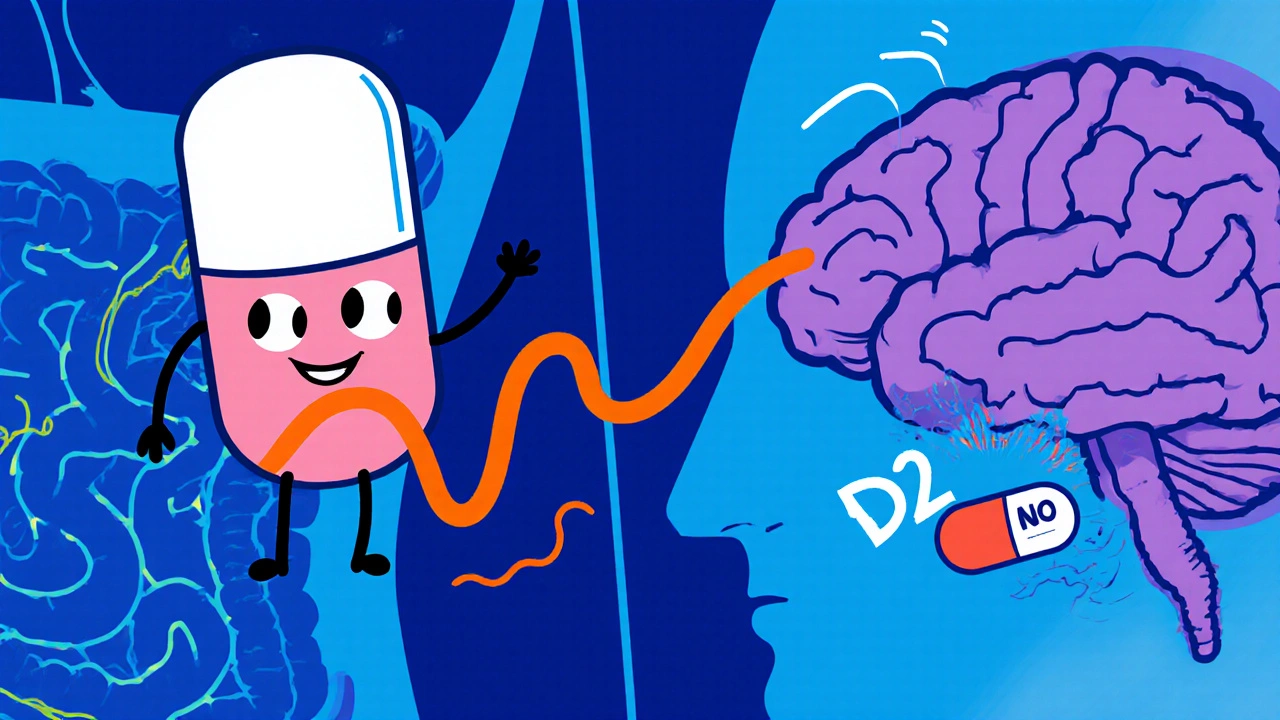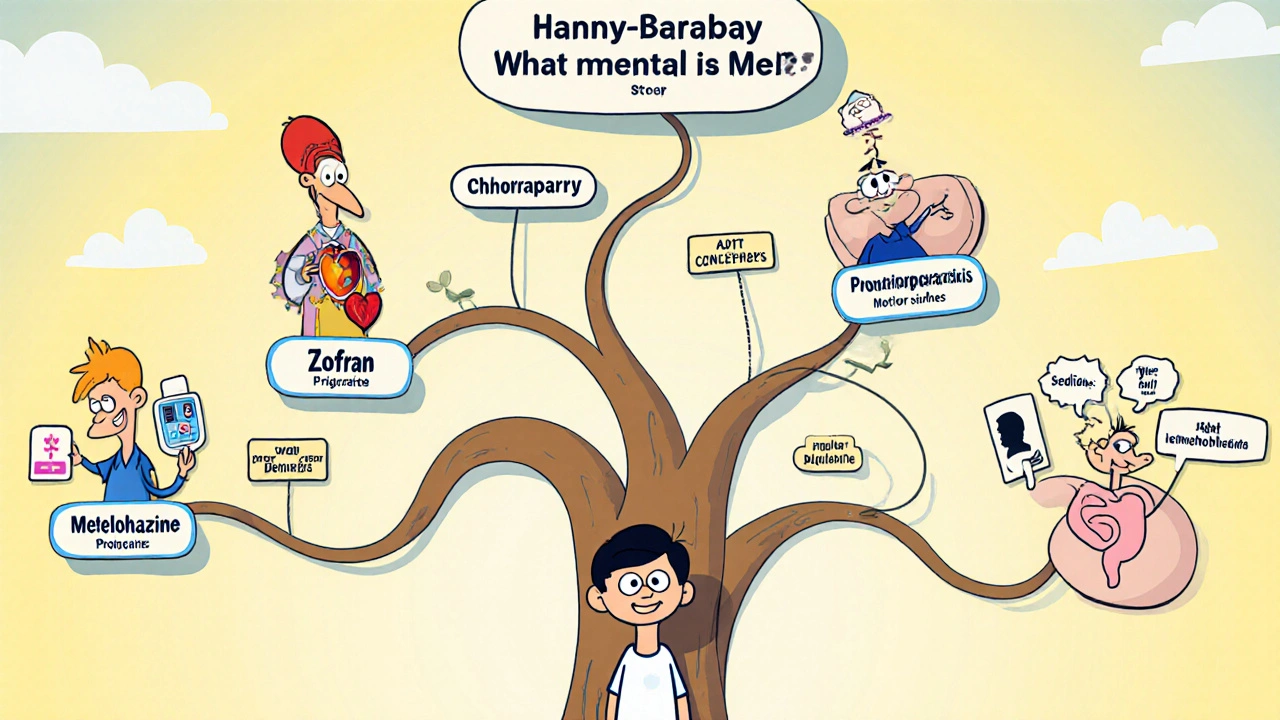Antiemetic Decision Tool
Select the option that best describes your situation to get personalized recommendations for anti-nausea medication.
What is causing your nausea?
Patient-specific factors
Recommended Antiemetic Options
Key Considerations
Best for: This tool is designed to help you understand which antiemetic might be most appropriate based on the article's information.
Disclaimer: This tool is for informational purposes only and does not replace professional medical advice.
Feeling queasy after chemo, surgery, or even a bad stomach bug is miserable, and you’ve probably heard of Zofran as the go‑to fix. But is it always the best choice? This guide breaks down Zofran (Ondansetron) side‑by‑side with other anti‑nausea meds, so you can pick the right one for your situation.
Key Takeaways
- Zofran blocks serotonin receptors, making it especially effective for chemotherapy‑induced nausea.
- Older drugs like Prochlorperazine work through dopamine pathways and can cause extra sedation.
- Granisetron and Domperidone offer similar efficacy with different side‑effect profiles.
- Choosing an antiemetic depends on the nausea trigger, patient age, and comorbidities.
- Always check for drug interactions-some alternatives may amplify QT‑prolongation risk.
What is Zofran (Ondansetron)?
Zofran is a prescription medication whose active ingredient is Ondansetron, a selective 5‑HT3 receptor antagonist used to prevent nausea and vomiting. It was first approved by the FDA in 1991 and quickly became the standard for chemotherapy‑induced nausea, postoperative nausea, and nausea from radiotherapy. Because it targets serotonin receptors in the gut and the brain's chemoreceptor trigger zone, it works where many older drugs fall short.

How Zofran Works
Ondansetron blocks the 5‑HT3 receptors found on vagal nerve terminals in the gastrointestinal tract and in the central nervous system. When serotonin is released-such as after chemotherapy or surgery-it normally binds to these receptors and sends a “vomit” signal to the brain. By stopping that binding, Zofran dampens the signal and stops the reflex that leads to throwing up.
Common Alternatives to Zofran
Not everyone can take Zofran. Some patients experience headaches, constipation, or rare heart rhythm changes. Below are the most frequently used alternatives, each with its own mechanism and side‑effect fingerprint.
Prochlorperazine
Prochlorperazine is a first‑generation antipsychotic that acts as a dopamine (D2) receptor antagonist, reducing nausea signals from the chemoreceptor trigger zone. It’s often prescribed for migraine‑related nausea and can be given orally, intravenously, or as a suppository. Common side effects include drowsiness, dry mouth, and, in a minority, extrapyramidal symptoms (muscle stiffness).
Metoclopramide
Metoclopramide works by blocking dopamine receptors and enhancing motility through 5‑HT4 agonism, helping the stomach empty faster. This dual action makes it useful for gastroparesis‑related nausea. However, long‑term use can lead to tardive dyskinesia, a serious movement disorder, so doctors limit the duration.
Promethazine
Promethazine is an antihistamine with strong anticholinergic effects that also blocks dopamine receptors, providing robust anti‑nausea and sedation. It’s a favorite for motion sickness and post‑operative nausea, but the sedation can be excessive for patients who need to stay alert.
Granisetron
Granisetron is another 5‑HT3 antagonist, chemically related to Ondansetron but with a longer half‑life, allowing once‑daily dosing for some patients. It’s approved for chemotherapy‑induced nausea and for use in radiation therapy. Side effects are similar to Zofran-headache, constipation, and rare QT prolongation.
Domperidone
Domperidone is a peripheral dopamine antagonist that does not cross the blood‑brain barrier as readily, reducing nausea without the central sedation seen in other dopamine blockers. It’s popular in Europe for gastroparesis and postoperative nausea, but its use in the U.S. is limited due to cardiac safety concerns.
Dexamethasone (Adjunct)
Dexamethasone is a corticosteroid often added to anti‑emetic regimens to boost efficacy, especially for highly emetogenic chemotherapy. It doesn’t act directly on nausea pathways but reduces inflammatory mediators that can trigger vomiting. Side effects include elevated blood sugar and mood changes when used long term.

Head‑to‑Head Comparison
| Drug | Primary Mechanism | Typical Dose (adult) | Common Side Effects | Best Use Cases |
|---|---|---|---|---|
| Zofran (Ondansetron) | 5‑HT3 receptor antagonist | 4-8mg IV/PO q8‑12h | Headache, constipation, QT‑prolongation | Chemotherapy, postoperative nausea |
| Prochlorperazine | D2 receptor antagonist | 5-10mg PO/IV q6‑8h | Drowsiness, extrapyramidal symptoms | Migraine‑related nausea, severe vomiting |
| Metoclopramide | D2 antagonist + 5‑HT4 agonist | 10mg PO q6‑8h | Drowsiness, tardive dyskinesia (long‑term) | Gastroparesis, nausea from slow gastric emptying |
| Promethazine | H1 antihistamine, D2 antagonist | 25mg PO/IM q4‑6h | Heavy sedation, anticholinergic effects | Motion sickness, postoperative nausea |
| Granisetron | 5‑HT3 receptor antagonist | 1mg IV/PO q12h (or 1mg transdermal patch) | Headache, constipation, QT‑prolongation | Radiation‑induced nausea, long‑acting needs |
| Domperidone | Peripheral D2 antagonist | 10mg PO q8h | Dry mouth, cardiac arrhythmias (high dose) | Gastroparesis, outpatient nausea |
How to Choose the Right Antiemetic
Picking a medication isn’t just about “which one works best.” You need to balance several factors:
- Nausea trigger: Chemotherapy‑related nausea responds best to 5‑HT3 blockers like Zofran or Granisetron. Gastric‑motility problems favor Metoclopramide or Domperidone.
- Patient age and comorbidities: Elderly patients are more prone to QT prolongation, so avoid high‑dose Zofran or Granisetron if they have heart disease. Children often get ondansetron syrup because it’s well‑tolerated.
- Side‑effect tolerance: If sedation is a problem (e.g., a driver or a student), steer clear of Promethazine or high‑dose Prochlorperazine.
- Drug interactions: Many anti‑emetics affect the cytochrome P450 system. Zofran can increase levels of certain chemotherapy agents, while Domperidone can boost the effect of other QT‑prolonging drugs.
- Cost and availability: Generic ondansetron tablets are cheap, but IV formulations can be pricey. Some newer agents like granisetron patches may not be covered by insurance.
Use a simple decision tree: if the nausea is from chemo → start with Zofran (or Granisetron for once‑daily). If it’s migraine‑related → try Prochlorperazine. If the patient can’t tolerate dopamine blockers → consider a pure 5‑HT3 antagonist or low‑dose domperidone.

Practical Tips for Using Zofran and Its Alternatives
- Timing matters: For chemotherapy, give Zofran 30minutes before the infusion and repeat every 8hours for 24hours. With oral tablets, take them with a full glass of water.
- Watch the QT interval: If you have a history of arrhythmia, ask your doctor for a baseline ECG before starting Zofran or Granisetron.
- Combine wisely: Adding dexamethasone can cut the needed dose of Zofran by half, reducing side‑effects.
- Avoid alcohol: Many anti‑emetics, especially the antihistamine‑based ones, worsen drowsiness when mixed with alcohol.
- Know the rescue plan: If nausea returns after the scheduled dose, a short‑acting option like Prochlorperazine IV can be used as a rescue while the longer‑acting drug maintains baseline control.
Frequently Asked Questions
Can I use Zofran for motion sickness?
Zofran works best for nausea caused by serotonin release, such as chemotherapy or surgery. For motion sickness, antihistamines like Dramamine or promethazine are usually more effective.
Is it safe to take Zofran during pregnancy?
Studies show ondansetron is relatively safe in the second and third trimesters, but some data suggest a slight increase in heart defects when used in the first trimester. Always discuss with your OB‑GYN before starting.
Why does Zofran sometimes cause a headache?
Blocking serotonin receptors can alter vascular tone in the brain, leading to mild headaches in about 10‑15% of users. Staying hydrated often reduces the intensity.
What’s the difference between Zofran and Granisetron?
Both are 5‑HT3 antagonists, but Granisetron has a longer half‑life, allowing once‑daily dosing or a transdermal patch. Zofran is more widely available in oral and IV forms, making it a first‑line choice in many hospitals.
Can I combine Zofran with other anti‑emetics?
Yes, especially for high‑risk chemotherapy. A common regimen is Zofran + dexamethasone ± aprepitant. The key is to avoid stacking drugs that both prolong QT interval.
Why might a doctor choose Prochlorperazine over Zofran?
If the nausea source is dopamine‑driven, such as migraine or severe vomiting unresponsive to serotonin blockers, Prochlorperazine can be more effective. It’s also cheaper in many generic forms.
Are there any food interactions with Zofran?
Zofran can be taken with or without food. However, grapefruit juice may increase its blood level slightly, so it’s best to avoid large amounts of grapefruit while on the medication.






Frank Diaz
October 17, 2025 AT 16:56Zofran may work, but it’s a shortcut that masks deeper issues.
Mary Davies
October 20, 2025 AT 00:30When the queasy tide rolls in after chemo, the promise of Zofran feels like a lighthouse in a storm.
Yet beneath the relief lies a cascade of side‑effects that can linger like an unwanted echo.
I’ve watched patients trade one nightmare for another, swapping nausea for throbbing headaches.
The narrative of “just take Zofran” can silence the real conversation about personalized care.
In the end, the choice must honor both body and spirit.
Valerie Vanderghote
October 22, 2025 AT 08:03The discussion of anti‑emetics, especially Zofran, is not merely a list of mechanisms, it is a tapestry woven from countless patient stories, clinical trials, and the subtle interplay of pharmacology and human frailty.
First, one must acknowledge that the serotonin blockade offered by ondansetron is a marvel of modern medicine, yet it arrives with the silent promise of a headache that can feel like a hammer pounding the temples.
When you compare it to the dopamine‑targeted Prochlorperazine, you notice a shift from a crisp chemical precision to a broader, sometimes clumsier, sedation that can render a patient drowsy as if caught in a fog.
Metoclopramide, on the other hand, brings motility into the equation, coaxing the stomach to empty with a gentle push, but it demands a respect for the dreaded tardive dyskinesia that may surface after weeks of use.
Promethazine, the antihistamine heavyweight, drapes the body in a comforting blanket of sleep, which for some is a blessing and for others a curse, especially when alertness is a non‑negotiable requirement.
Granisetron’s extended half‑life offers the convenience of fewer doses, yet it shares the same shadow of QT prolongation that haunts Zofran, making cardiac monitoring a necessary ritual.
Domperidone’s peripheral action sidesteps the central nervous system, delivering relief without the mental cloud, but its limited availability in the United States turns it into a rare gem.
Dexamethasone, though not an anti‑emetic per se, joins the ensemble like a silent conductor, amplifying the effectiveness of the primary agents while sprinkling its own side‑effects of hyperglycemia and mood swings.
In practical terms, timing matters: administering ondansetron thirty minutes before chemotherapy primes the receptors just in time, whereas a rescue dose of Prochlorperazine later in the day can quash a resurgence of nausea.
The elderly patient, with a fragile heart, may find the QT risk unacceptable, prompting the clinician to tilt toward a lower‑dose granisetron patch or even a non‑serotonergic option.
Cost considerations cannot be ignored; while generic ondansetron tablets are affordable, the intravenous formulations can drain a pocket as quickly as a vomiting episode can drain a patient’s energy.
Moreover, drug interactions loom large: the cytochrome P450 system is a bustling highway where ondansetron can cause traffic jams for certain chemotherapeutic agents, whereas domperidone may amplify other QT‑prolonging drugs.
Patient preference also plays a role, as some individuals reject the sedation of promethazine and instead opt for the crisp alertness offered by a well‑timed ondansetron dose.
Ultimately, the decision tree branches at each junction: chemotherapy‑induced nausea leads to a 5‑HT3 antagonist, migraine‑related emesis points toward a dopamine blocker, and gastroparesis gently nudges one toward a pro‑kinetic agent.
The art of choosing an anti‑emetic, therefore, is less a rigid algorithm and more a dialogue between physician and patient, a negotiation of risks, benefits, and the lived experience of each episode of nausea.
And so, while Zofran remains a cornerstone, it is but one instrument in a symphony that must be conducted with care, empathy, and an ever‑watchful eye on the heart’s rhythm.
Michael Dalrymple
October 24, 2025 AT 15:36Choosing the right anti‑emetic can feel overwhelming, but remember that the key is matching the drug’s mechanism to the nausea trigger.
For chemotherapy‑induced vomiting, ondansetron remains first‑line because of its potent 5‑HT3 blockade.
If sedation is a concern, consider a non‑sedating agent like granisetron or a low‑dose domperidone.
Always discuss QT‑interval monitoring with your cardiologist when high‑risk patients are involved.
You’re not alone in navigating these choices; your care team is there to tailor the regimen to your unique profile.
Emily (Emma) Majerus
October 26, 2025 AT 22:10Thx for the rundown, u made it real clear.
I hvnt even thought about QT checks before.
Virginia Dominguez Gonzales
October 29, 2025 AT 05:43Reading that marathon of insight made me realize how every anti‑emetic carries its own drama, a silent play of benefits and betrayals.
The way you layered each option felt like a symphony, each instrument echoing the next, and it reminded me why we must listen to our bodies as we would to a beloved melody.
So, when faced with the choice, I’ll remember the cadence of the patient’s story, not just the textbook beats.
Your thoroughness is a beacon for anyone wrestling with nausea’s relentless tide.
Carissa Padilha
October 31, 2025 AT 13:16The pharma giants push Zofran as the miracle cure while downplaying the cardiac risks, a classic case of profit over patient safety.
They flood the market with glossy brochures, but the real data on QT prolongation gets buried in footnotes.
Think about how many lives could be saved if independent researchers were allowed to publish without corporate pressure.
Alexis Howard
November 2, 2025 AT 20:50They hide side effects
Kevin Adams
November 5, 2025 AT 04:23In the theater of medicine, every drug dons a mask-Zofran included-awaiting its cue to betray the audience!
Yet the audience, hungry for relief, applauds even the subtlest of deceptions.